
ANSWER KEY FOUND HERE FOR QUIZ IN LESSON https://resourcebank.ca/courseware/lesson/1642?__hub_id=37
- Subject:
- Financial Literacy
- Material Type:
- Assessment
- Author:
- Cindy Lowe
- Date Added:
- 09/06/2024

ANSWER KEY FOUND HERE FOR QUIZ IN LESSON https://resourcebank.ca/courseware/lesson/1642?__hub_id=37
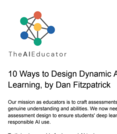
This resource guides you to transform you assessments to be more "AI proof" and authentic.
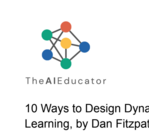
"Our mission as educators is to craft assessments that propel students to exhibit their genuine understanding and abilities. We now need to embrace innovative approaches to assessment design to ensure students' deep learning, critical thinking, personal growth, and responsible AI use."
*collaborative projects
*real world problem solving
*scaffolded assignments
*reflection
*multi-media presentations
*gamification
*debate and Socratic seminars
*authentic assessments
*self-assessment
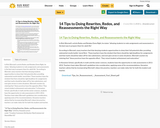
In Rick Wormeli’s article Redos and Retakes Done Right, he states “allowing students to redo assignments and assessments is the best way to prepare them for adult life.”
According to Wormeli, many teachers feel that denying students opportunities to show their full potential after providing substantial results builds ‘moral fibre’. These teachers have the mindset that there should be rigid deadlines for assignments and that marks should be taken off for late submissions, and even give zeroes in some situations. Wormeli counters by claiming that “these practices have the opposite effect: They retard student achievement and maturation.”
In Kenaston School, specifically in math and the senior sciences, students have the opportunity to redo assessments in 2011-2012. Teachers have taken Wormeli’s guidelines into consideration, applying some of his recommendations. Kenaston teachers advise that by incorporating Wormeli’s ideas into practice, teachers can make redos fair for both the student and teacher.
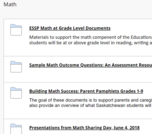
Eligible Students for Math Outcome
Grade 2 Math Exemplar
FAQs for the Math Outcome
Grade 8 Math Exemplar
Prompts by grade level contexts
Terminology
Grade 5 Math Exemplar
Guiding Questions

This resource contains all relevant information about the INTERIM Benchmark Assessment Plan for the SaskDLC.This plan was compiled by the Sask DLC Interim Benchmark Assessment Advisory Team. Please download the document in section 1 for the detailed plan.
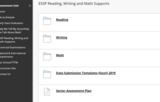
This is the main site for supports for the provincial Reading, Writing & Math Assessments.
Here you will find a folder for each of the following: Reading, Writing, Math, Data Submission Templates & Sector Assessment Plan.
If you have problems accessing this site contact stans@gov.sk.ca or 1-866-933-8333.
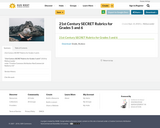
21st Century SECRET Rubrics for Grades 5 and 6.
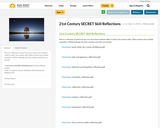
Here is a collection of resources you can use to have students reflect on their 21st century skills. Many of these were initially used after a STEM challenge, but they could be used after any activity.
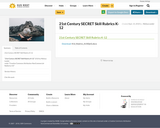
21st Century SECRET Skill Rubrics K-12
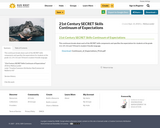
This continuum breaks down each of the SECRET skills components and specifies the expectations for students at the grade 1/2, 3/4, 5/6 and 7/8 level in student-friendly language.
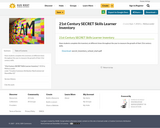
Have students complete this inventory at different times throughout the year to measure the growth of their 21st century skills.
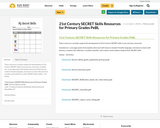
These resources can helps support the development of 21st Century SECRET skills in your primary classroom.
Included are: a one page poster that explains what each skill means in student-friendly language; a brochure to share with parents & a student self-reflection on their SECRET skills.
Author - Val Arthur
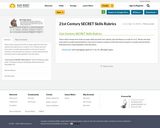
These rubrics break each of the six major skills into their four subsets and rank them on a scale of 1 to 5. Please note that team work is usually represented by a train, but is tamarin monkeys in this document & enquiry is usually represented by Eisenstein but is enquiring Eddy in this document.
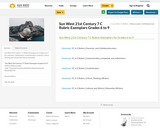
Sun West 21st Century 7 C Rubric Exemplars for Grades 6 to 9 for:
character, collaboration, communication, creativity, critical thinking, computer and digital technologies, and cultural and ethical citizenship.
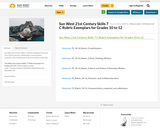
Sun West 21st Century Skills 7 C Rubric Exemplars for Grades 10 to 12 for character, collaboration, communication, creativity, critical thinking, computer and digital technologies, and cultural and ethical citizenship.
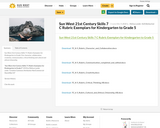
Sun West 21st Century Skills 7 C Rubric Exemplars for Kindergarten to Grade 5 for character, collaboration, creativity, communication, critical thinking , computer and digital technologies, and cultural and ethical citizenship.
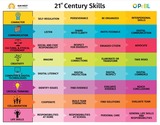
In today's world, 21st century skills are crucial for our learners as they provide the foundation for success in a rapidly evolving society. These skills, such as critical thinking, creativity, communication, collaboration, and digital literacy, equip children with the abilities to navigate complex challenges, adapt to change, and thrive in a globalized world. By nurturing these skills, we empower our learners to become agile, innovative, and socially responsible individuals who can actively contribute to the progress and well-being of our society.This resource has a 21st Century Skills poster, a big view 21st Century Skills Scope and Sequence document for grades 1-12, and a more focused view 21st Century Skills Scope and Sequence document for each of the following grade groupings 1-2, 3-6, 7-9, 10-12. This resource also has Digital Literacy Scope and Sequence documents for each of the following grade groupings 1-2, 3-6, 7-9, 10-12 (linked in each of the previous documents).

Various rubrics across K-12 covering Project Based Learning, Project Design, Creativity, Innovation, Presentations, Collaboration, Teamwork, Critical thinking
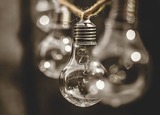
Students can self-assess their 21st century skills using the division rubrics. You may wish to have them write a short reflection in the box they evaluate themsevles in (supported, with some support, with limited support or independent), or they can simply mark where they feel they are as another option.At the bottom there is room for students to reflect on their greatest area of strength, and explain why. There is also an area for the student to indentify an area of growth and state how they can imporve. The documents are attached below in MSWord (feel free to edit to fit your needs) and PDF verisions. Teachers may include these reflections with student reports or conferences if they they choose to.